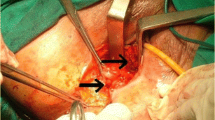Abstract.
Introduction: Sphincterotomy can be avoided in the repair of high anorectal or rectovaginal fistulas by use of rectal advancement flaps. Methods: Between 1986 and 1998, 22 patients with high anorectal and 15 patients with rectovaginal fistulas underwent fistulectomy without sphincterotomy and consecutive transanal rectal advancement flap repair. Results: Primary healing was achieved in 81 % (30/37 patients). There was no disturbance of continence though anal resting pressures decreased postoperatively. Recurrences occurred in 4 of 12 patients with Crohn's disease (2 anorectal, 2 rectovaginal) and in 1 patient with traumatic anorectal fistula. There were no recurrences in patients with cryptoglandular disease, while the operation failed in 2 patients with ergotamine-induced fistulas. Conclusions: This operative approach achieves a high primary healing rate with optimal functional outcome. Despite good results the indication should be set carefully in patients with Crohn's disease.
Zusammenfassung.
Einleitung: Bei der Behandlung hoher anorectaler und rectovaginaler Fisteln mittels transanaler endorectaler Verschiebelappenplastik wird eine Spaltung des M. sphincter ani externus vermieden und der Anorectalring vollständig erhalten. Methoden: Von 1986–1998 wurde dieses Verfahren bei 22 Patienten mit hohen anorectalen und 15 Patientinnen mit rectovaginalen Fisteln angewandt. Ergebnisse: Die primäre Heilungsrate betrug 81 % (30/37 Patienten). Trotz signifikanter Abnahme des analen Ruhedrucks und des Ruhevektorvolumens kam es bei keinem Patienten zu Kontinenzstörungen. Rezidive traten bei 4 von 12 Patienten mit M. Crohn (33 %; 2 anorectal, 2 rectovaginal) und einem Patienten mit traumatischer anorectaler Fistel auf (11 %). Es fanden sich keine Rezidive in der Gruppe der Patienten mit kryptoglandulären Fisteln, während 2 Patienten mit Fisteln auf dem Boden eines analen Ergotaminabusus ein Rezidiv erlitten. Schlußfolgerungen: Die endorectale Verschiebelappenplastik stellt ein unkompliziertes und rezidivarmes Verfahren zur Behandlung hoher analer Fisteln dar. Trotz guter Ergebnisse muß die Indikation beim Vorliegen eines M. Crohn streng gestellt werden.
Similar content being viewed by others
Author information
Authors and Affiliations
Rights and permissions
About this article
Cite this article
Willis, S., Rau, M. & Schumpelick, V. Chirurgische Therapie hoher anorectaler und rectovaginaler Fisteln mittels transanaler endorectaler Verschiebelappenplastik. Chirurg 71, 836–840 (2000). https://doi.org/10.1007/s001040051145
Issue Date:
DOI: https://doi.org/10.1007/s001040051145




